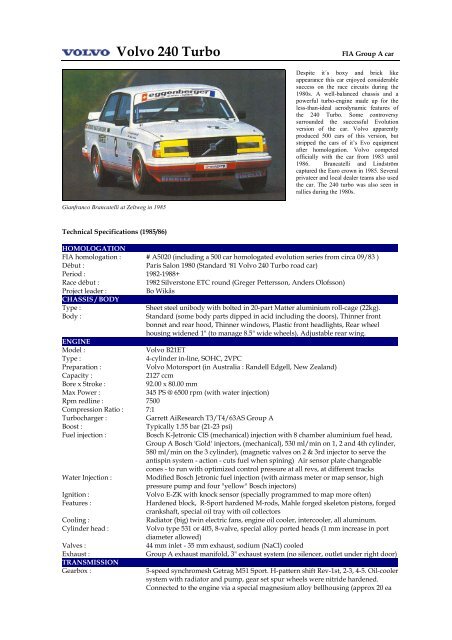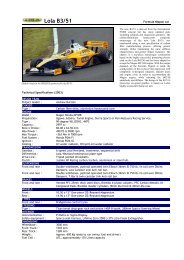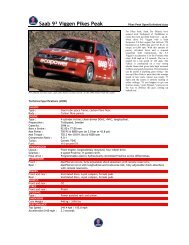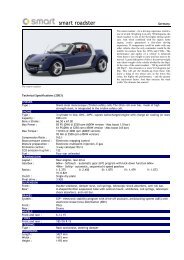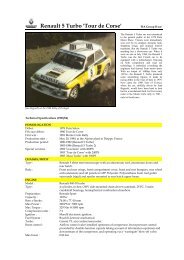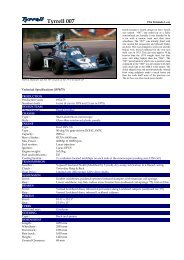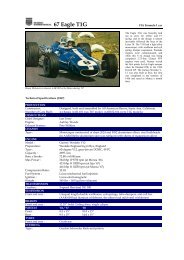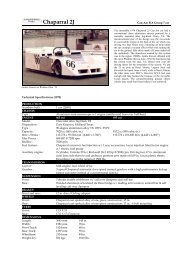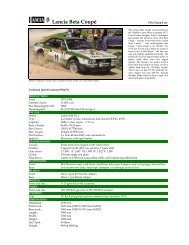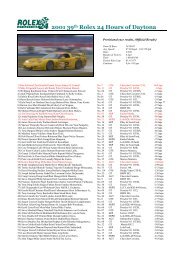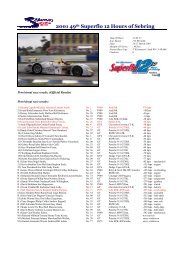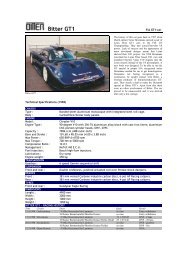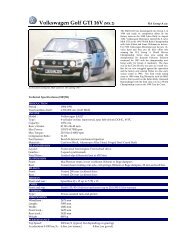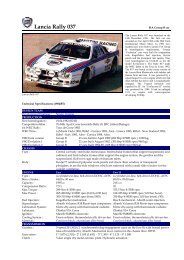85 Volvo 240 Turbo - Motorsports Almanac
85 Volvo 240 Turbo - Motorsports Almanac
85 Volvo 240 Turbo - Motorsports Almanac
You also want an ePaper? Increase the reach of your titles
YUMPU automatically turns print PDFs into web optimized ePapers that Google loves.
Gianfranco Brancatelli at Zeltweg in 19<strong>85</strong><br />
Technical Specifications (19<strong>85</strong>/86)<br />
<strong>Volvo</strong> <strong>240</strong> <strong>Turbo</strong> FIA Group A car<br />
Despite it´s boxy and brick like<br />
appearance this car enjoyed considerable<br />
success on the race circuits during the<br />
1980s. A well-balanced chassis and a<br />
powerful turbo-engine made up for the<br />
less-than-ideal aerodynamic features of<br />
the <strong>240</strong> <strong>Turbo</strong>. Some controversy<br />
surrounded the successful Evolution<br />
version of the car. <strong>Volvo</strong> apparently<br />
produced 500 cars of this version, but<br />
stripped the cars of it’s Evo equipment<br />
after homologation. <strong>Volvo</strong> competed<br />
officially with the car from 1983 until<br />
1986. Brancatelli and Lindström<br />
captured the Euro crown in 19<strong>85</strong>. Several<br />
privateer and local dealer teams also used<br />
the car. The <strong>240</strong> turbo was also seen in<br />
rallies during the 1980s.<br />
HOMOLOGATION<br />
FIA homologation : # A5020 (including a 500 car homologated evolution series from circa 09/83 )<br />
Début : Paris Salon 1980 (Standard '81 <strong>Volvo</strong> <strong>240</strong> <strong>Turbo</strong> road car)<br />
Period : 1982-1988+<br />
Race début : 1982 Silverstone ETC round (Greger Pettersson, Anders Olofsson)<br />
Project leader : Bo Wikås<br />
CHASSIS / BODY<br />
Type : Sheet steel unibody with bolted in 20-part Matter aluminium roll-cage (22kg).<br />
Body : Standard (some body parts dipped in acid including the doors), Thinner front<br />
bonnet and rear hood, Thinner windows, Plastic front headlights, Rear wheel<br />
housing widened 1" (to manage 8.5" wide wheels), Adjustable rear wing.<br />
ENGINE<br />
Model : <strong>Volvo</strong> B21ET<br />
Type : 4-cylinder in-line, SOHC, 2VPC<br />
Preparation : <strong>Volvo</strong> Motorsport (in Australia : Randell Edgell, New Zealand)<br />
Capacity : 2127 ccm<br />
Bore x Stroke : 92.00 x 80.00 mm<br />
Max Power : 345 PS @ 6500 rpm (with water injection)<br />
Rpm redline : 7500<br />
Compression Ratio : 7:1<br />
<strong>Turbo</strong>charger : Garrett AiResearch T3/T4/63AS Group A<br />
Boost : Typically 1.55 bar (21-23 psi)<br />
Fuel injection : Bosch K-Jetronic CIS (mechanical) injection with 8 chamber aluminium fuel head,<br />
Group A Bosch 'Gold' injectors, (mechanical), 530 ml/min on 1, 2 and 4th cylinder,<br />
580 ml/min on the 3 cylinder), (magnetic valves on 2 & 3rd injector to serve the<br />
antispin system - action - cuts fuel when spining) Air sensor plate changeable<br />
cones - to run with optimized control pressure at all revs, at different tracks<br />
Water Injection : Modified Bosch Jetronic fuel injection (with airmass meter or map sensor, high<br />
pressure pump and four "yellow" Bosch injectors)<br />
Ignition : <strong>Volvo</strong> E-ZK with knock sensor (specially programmed to map more often)<br />
Features : Hardened block, R-Sport hardened M-rods, Mahle forged skeleton pistons, forged<br />
crankshaft, special oil tray with oil collectors<br />
Cooling : Radiator (big) twin electric fans, engine oil cooler, intercooler, all aluminum.<br />
Cylinder head : <strong>Volvo</strong> type 531 or 405, 8-valve, special alloy ported heads (1 mm increase in port<br />
diameter allowed)<br />
Valves : 44 mm inlet - 35 mm exhaust, sodium (NaCl) cooled<br />
Exhaust : Group A exhaust manifold, 3" exhaust system (no silencer, outlet under right door)<br />
TRANSMISSION<br />
Gearbox : 5-speed synchromesh Getrag M51 Sport. H-pattern shift Rev-1st, 2-3, 4-5. Oil-cooler<br />
system with radiator and pump, gear set spur wheels were nitride hardened.<br />
Connected to the engine via a special magnesium alloy bellhousing (approx 20 ea
made)<br />
Ratios : I : 2.328:1<br />
II : 1.675:1<br />
III : 1.353:1<br />
IV : 1.145:1<br />
V : 1.000:1<br />
Clutch : AP metal sintered, hydraulically actuated<br />
Rear Axle : Alloy housing (two types) 1031 with bolt on tubes, steel (two types) with 1.5 degree<br />
negative camber + sensors for antispin system. Later development was lightweight<br />
carbon-fibre unit. Special drive shafts for negative camber and wheel center hub<br />
bolting system (left and right threads). Axle centre fitted with oil cooling system -<br />
pump and radiator.<br />
Final drive : Dana or ZF Limited slip diff. Gearing ratios 2.86, 3.15, 3.31, 3.73, 3.91, 4.10, 4.56,<br />
4.88.<br />
SUSPENSION<br />
Front : Bilstein short adjustable spring struts, VMS adjustable alloy A- arms, anti-roll bar.<br />
Rear : Steel or aluminum lower support arms, adjustable upper control arms adjustable<br />
panhard rod, Bilstein shockdampers, anti-roll bar.<br />
BRAKES<br />
Front : 330 mm ventilated discs with AP or Brembo alloy calipers<br />
Rear : 280 mm ventilated discs with AP or Brembo alloy calipers<br />
STEERING<br />
Type : Power-assisted rack-and-pinion - 2.6 or 3.5 turns.<br />
WHEELS<br />
Front and rear : 8 x 16" or 9 x 17" BBS, Compomotive, Ronal or Speedline - 90 mm center hub<br />
attachment, split or mono wheels.<br />
TIRES<br />
Front : Pirelli P7 25/62VR17 (Pirelli D3 was used in '86)<br />
Rear : Pirelli P7 26/64VR17 (Pirelli D3 was used in '86)<br />
(8 1/2" x 16" Avons in Australia)<br />
DIMENSIONS<br />
Wheelbase : 2640 mm<br />
Length : 4790 mm<br />
Width : 1710 mm<br />
Weight : Bit over class minimum of 1065 kg<br />
Fuel cell : 120 litre safety tank with 8-bar quick fill system.<br />
VOLVO <strong>240</strong> TURBO HISTORY<br />
In order to compete in group-A, <strong>Volvo</strong> Motorsport had to built atleast 500 "homologation" cars. So, in 1983 242<br />
"evolution" was brought to the market. All the cars were sold in the USA though few found their ways back to<br />
Sweden. All the cars had european front and so-called "flathood", even though they were mainly sold in the<br />
USA. There are also lots of other differences, such as the engine: B21 with modified 405 cylinder head, group-A<br />
type cam ("generation 1"), group-A turbo, group-A, intake manifold with "Bosch Gold" injectors, group-A<br />
exhaust manifold, special airmassmeter for use with water injection, group-a aluminum intercooler etc. Boost<br />
was set at 1.05bar and the output was very nice 225hp @ 5700 rpm and 340Nm @ 3300rpm! As usual for<br />
homologation specials, rumours exixted that only a small amount of the 500 cars had these parts installed and<br />
the rest were just original 242 turbos. The gearbox was surprisingly a M46, though it had aluminum housing<br />
and it's modified in other ways too (higher oil pressure, "fast shift" etc.). Also, a five-speed Getrag was<br />
available through special order. Clutch was ofcourse enforced and rear axle was the legendary "Dana 30" 1031<br />
with limited slip differential. Suspension featured <strong>Volvo</strong> Motorsport springs and "<strong>Volvo</strong> sport" shocks (made<br />
by DeCarbon). Bushings were harder ones and anti-sway bars are the same as in original turbo versions. The<br />
car came with different wheel choices to suit the buyers needs, from original 6x15" Virgo to 9x17" (without a<br />
doubt the most amazing looking wheel, 9x17" 3-piece split wheel made by BBS. Rare and *expensive*.). The<br />
interior was usually black leather with extra gauges and <strong>Volvo</strong>'s "sport" steering wheel. These cars are indeed<br />
rare and valuable collectors items, if you find one in original shape and with the gr-A type parts, don't hesitate<br />
to buy it!<br />
1983 FIA GROUP A HOMOLOGATED 242 TURBO by Steve Seekins VCOA<br />
This two-door 242 series car arrived in the dealerships in 1983 as a result of the need to manufacture a<br />
minimum number of cars to qualify them for racing in a production class. One of the enigmas about these cars<br />
is exactly what differences there were from the rest of the <strong>240</strong> series turbos. It seems that everyone has a<br />
different answer. The question often elicits just a clandestine smile from <strong>Volvo</strong> Corporation types, however, I<br />
have been able to piece together a few interesting items. These cars were fitted with a B21ET engine in place of<br />
the B21FT installed in other cars. The ET version was the European version of the turbo engine and provided<br />
some extra power over the FT. I am guessing, but I suspect that these engines were fitted with slightly different
pistons and other internal parts as well, because they were intended to be used for racing with a different<br />
manifold and the larger T04 Garrett turbocharger. I have heard, but cannot be certain, that they may be<br />
equipped with larger clutches and lightened flywheels. Thirty of the cars were returned to Sweden for racing<br />
after being imported to the US. These cars were fitted with other items besides the larger turbos. Included in<br />
the list are <strong>Volvo</strong> Electronic Water Injection Systems with an eight gallon tank, Getrag five-speed gearbox,<br />
limited slip differential, ventilated disc brakes on all four wheels with aluminum AP-Lockheed four piston<br />
calipers, adjustable front/rear brace balance, magnesium alloy wheels (8.5/8.75x16") with center lock nut and<br />
Pirelli P7 245/45 VR16 tires. Final drive ratios were available ranging from 1:4.56 to 1:3.15. The car also had a<br />
31 gallon fuel tank. For instrumentation, the racing cars were equipped with full digital instruments. These<br />
were vertical stacks of green, orange and red lights. Although the US drivers have indicated a preference for<br />
the analog type gauges, the European racing drivers said this digital arrangement worked very well for them<br />
since all they needed to know was that the system was performing properly, marginally, or had failed. The xray<br />
picture also shows the special lightweight alloy roll cage that was installed for racing (not legal in the US),<br />
the four corner pneumatic jacks, trunk mounted battery, extra bracing for the front shock towers, and the rear<br />
spoiler. These rear spoilers were reputedly supplied with all cars, unmounted in the trunk. I don't recall seeing<br />
any of them, so I wonder what happened to them? Oh, and by the way the engine with all the goodies on it<br />
develops 340 HP at 6600 RPM and 310 ft/lbs. of torque at 4000 to 5000 RPM and will power the car to speeds<br />
over 150 MPH.<br />
HOW THE 1983 "FLATHOODS" WERE CAME TO BE by Duncan LaBay VCOA<br />
In the last issue, I mentioned the very rare 1983 "flat-hood" 242 Group-A <strong>Turbo</strong>s. <strong>Volvo</strong> manufactured 500 of<br />
these cars to meet production requirements for Group-A sedan class racing in Europe. Some number of them<br />
were sold to private customers in the US through the <strong>Volvo</strong> dealer network. Different sources tell different<br />
stories about the distribution of these vehicles. According to various US sources, all 500 were brought to the<br />
United States through Portsmouth, Virginia port of entry. Some 30 were then sent back to Europe for racing. In<br />
racing trim, the cars had bigger (T04) turbo, water injection, a different intake manifold, four wheel vented disc<br />
brakes, full digital instrumentation, light alloy roll cages, and different front struts. The vehicles which stayed<br />
in the US were changed back to standard 1983 <strong>Turbo</strong> specs in these areas, although the Group-A <strong>Turbo</strong>s sold<br />
here did retain the GT springs, a factory intercooler, and the 242-style European front end sheetmetal.<br />
Although <strong>Volvo</strong> Cars of North America spokespeople indicate the Group-A <strong>Turbo</strong> has the standard 161 HP<br />
turbo output, those who have driven these cars all say they are definitely faster than a stock turbo with an<br />
intercooler added. Supposedly, all Group-A <strong>Turbo</strong>s sold in the US came through with manual sunroofs, while<br />
the European racing cars did not have sunroofs. One unconfirmed source suggests 312 of the 500 vehicles had<br />
4-speed manual plus overdrive transmissions, with the balance being automatics. The vehicles were produced<br />
in a variety of colors, although metallic blue, metallic silver and black seem to be the most common in the US.<br />
Information on the Group-A <strong>Turbo</strong>s is scarce and conflicting. Any club member who has one of these cars is<br />
encouraged to check the VIN and VIC plates, and let me know of any discrepancies from the information<br />
shown here. (An article from ROLLING the VCOA's bi-monthly magazine. Vol. 9 No. 3 May/June 1991)<br />
'ONE HOT LAP' with Ulf Granberg in a <strong>240</strong> <strong>Turbo</strong> Group A by Angus MacKenzie<br />
MONZA Race Circuit - Italy 1986 - We flashed past Monza's pit lane. The tacho's showing 7,000 rpm, the<br />
turbo boost gauge is reading 1.4 bar (20.5 psi). That means over 250 km/h and we've just shot past the 200<br />
metre braking marker at the first chicane. Not 10 minutes earlier European Touring Car Champion Thomas<br />
Lindstrom had driven slowly around the fast 5.8 km Monza circuit and carefully explained the breaking and<br />
gearchange points. "Keep right and brake at 200 metres," he said as we dawdled into Monza's first chicane in<br />
<strong>Volvo</strong> 740 <strong>Turbo</strong> Estate. So even as team-mate Ulf Granberg, now chauffeuring me in the works <strong>Volvo</strong> <strong>240</strong>T<br />
Group A race car, finally mashed the brake pedal at the 150 metre mark, I knew he was having a big go. The<br />
full harness bites into my shoulders as the <strong>Volvo</strong> squirms under brakes. Bam! Bam! Bam! Granberg heels and<br />
toes back to second gear with machine gun rapidity, swinging the suede covered Momo steering wheel hard<br />
left into the first part of the chicane. Even as we bounce off the kerbing, Granberg dabs at the throttle and<br />
throws the <strong>Volvo</strong> to the right, up and over the kerb. Suddenly the <strong>240</strong>T spits sideways - simultaneously<br />
Granberg grabs an armful of opposite lock and boots the accelerator. He brings the car back onto line by the<br />
scruff of its neck. We jumped the kerbs again on the second left-right kink of the chicane then on the gas hard -<br />
third, fourth, fifth - into the Curva Grande. He feathers the throttle through the long sweeping right hander,<br />
the <strong>Volvo</strong>'s inside wheels lifting as we delicately walk the tight-rope between under and oversteer. Past the<br />
clipping point and hard on the throttle again as we scream down toward the second chicane. Granberg stands<br />
on the brakes as we flash under the Campari bridge, rapid fire again back to second gear as he steadies the<br />
<strong>Volvo</strong> for the single left-right flick ahead. We bounce the kerbs again and it's full-bore into the double apex<br />
Curve di Lesmo. We charge through the first Lesmo flat in third, then Granberg grabs fourth as we slide up<br />
onto the kerbing in readiness for the second Lesmo. Again the <strong>Volvo</strong> corkscrews as the outside tyres bite and<br />
the inside wheels lift clear of the tarmac. We run wide up onto the kerbing again - "You must use all the track"<br />
as Granberg grabs fifth through the gentle left hand kink on the run down to the Variante Ascari. We're flat in<br />
fifth as the track dips under Monza's huge banked oval. The Variante Ascari, named after the great Italian<br />
World Champion killed there while testing in 1955, is the fastest of Monza's three chicanes. Granberg hauls the<br />
<strong>Volvo</strong> back from just on 250 km/h and downshifts twice. We're over the kerb on the first left hander but the
left hand wheels are in the air so there's no shock through the suspension. A stab on the throttle and then<br />
through the next right-left wiggle, Granberg sawing at the wheel as the car drifts from kerb to kerb. Full bore,<br />
full boost and 340 bhp hurls us down the short straight towards the Parabolica. It's tight, deceptively tight - at<br />
first we seem to be travelling way too quickly - but Granberg clips the inside kerb clearly and lets the <strong>Volvo</strong><br />
run wide for the run onto the main straight. Get the Parabolica right and you'll be quick all the way down the<br />
main straight. Get it wrong... The brilliant Austrian Jochen Rindt died here in his Lotus in 1970. He was<br />
posthumously awarded the World Championship. Granberg brings the <strong>Volvo</strong> into the pit lane at a brisk clip.<br />
The stop watches confirm we've lapped within a second or two of race pace. Full face helmets, the brap-brap of<br />
the exhaust and the howl of the drive train make conversation impossible, but Granberg, the Swedish train<br />
driver who led yesterday's first round of the European Touring Car Championship until a head gasket blew on<br />
the <strong>Volvo</strong>, turns and lifts his eyebrow quizzically. My thumbs up sign is returned with a nod.<br />
THE GROUP A VOLVO <strong>240</strong> TURBO IN AUSTRALIA by Anthony Hyde<br />
1984 - The Belgium <strong>Volvo</strong> Dealer Team ran the LH drive semi-works built GpA in the1984 European<br />
championship season. The car was shipped to New Zealand after the season finished, purchased by Mark<br />
Petch a NZ engineer/businessman/race car driver. Petch formed a race team partnership with driver Robbie<br />
Francevic, and were the only privateers in the world running a GpA <strong>240</strong> without works support.<br />
19<strong>85</strong> - In January, Mark Petch Racing won the famous Wellington 500 street race in NZ, starting from rear of<br />
grid, with drivers R.Francevic, and Belgian, Michel Delcourt. Soon after in 19<strong>85</strong> the car was shipped to<br />
Australia, being a late entry into the Australian Touring Car Championship where it performed very well.<br />
Later in the year it competed at Bathurst in the James Hardie 1000.<br />
1986 - The car was sold to '<strong>Volvo</strong> Australia', and ran under the '<strong>Volvo</strong> Dealer Team' banner. The consortium<br />
comprised of Valvoline Australia, Australian & New Zealand <strong>Volvo</strong> Dealers (who contributed 40% to the race<br />
budget), Mark Petch Motorsport, and other sponsors. Technical support was provided by the <strong>Volvo</strong><br />
Motorsport Dept. in Sweden. The first debut of the <strong>Volvo</strong> Dealer Teams' 2nd GpA <strong>240</strong>T (RH drive) was at<br />
Adelaide International Raceway in April 1986 where it came in 4th - driver John Bowe. This 2nd car was<br />
originally the Factory Euro test car, being fully rebuilt by the Factory before shipment to Oz. In May 1986,<br />
Robbie Francevic took over the RH drive car and John Bowe campaigned the older LH drive car. <strong>Volvo</strong><br />
ultimately won the '1986 ATCC', the jewel of Australian motorsport, a brilliant result.<br />
1987 - <strong>Volvo</strong> pulls out of racing worldwide due in part to GpA rule changes. Eventually the LH drive car (plus<br />
another 2 RH drives) were sold by '<strong>Volvo</strong> Australia' to '<strong>Volvo</strong> Finland', where later Leif Wiik won the 1987<br />
Finnish Touring Car Championship. Reportably the car still exists.<br />
VOLVO <strong>240</strong> TURBO IN THE EUROPEAN TOURING CAR CHAMPIONSHIP<br />
Take a <strong>Volvo</strong> <strong>240</strong> <strong>Turbo</strong> in two doors guise and let this car compete in the European Touring Car<br />
Championship (ETCC) following the Group A rule book and you let a BMW 635 CSI, a Jaguar XJ-S and a Rover<br />
3500 bite the dust. Sounds simple, but it is a fact though. Already during its first race of the 1984 season the <strong>240</strong><br />
was heading the field 100 of 150 laps. In 1984 the <strong>Volvo</strong> <strong>240</strong> made its début in the ETCC which had started in<br />
1963. A year later the <strong>240</strong> won the championship. 1986 would have ended with another championship had not<br />
primarily Tom Walkinshaw with his Rover protested against the <strong>240</strong>. This car was not competing according to<br />
the rules in Tom Walkinshaws opinion. The Fédération Internationale du Sport Automobile (FISA) disqualified<br />
<strong>Volvo</strong>, because the <strong>240</strong> on Anderstorp was driving on unleaded standard petrol with an octane rate of 99,<br />
while on Zeltweg the car was competing with a prohibited size of the fuel tank and an illegal dashboard. Two<br />
victories were therefore deleted. On the other hand, the FISA was already keeping an eye on <strong>Volvo</strong> in 19<strong>85</strong>.<br />
The <strong>240</strong> <strong>Turbo</strong> was homologated for the American market in 1983. Five hundred evolution models were<br />
delivered there and then, but the American authorities had not registered the <strong>240</strong>s. The rules of the FISA were<br />
the reason why <strong>Volvo</strong> retreated from the championship two weeks after the last race on Estoril in 1986.<br />
The car<br />
A car from the Group A class of the ETCC has got to be a four-seater, which has to be build in a series of at<br />
least 500 identical vehicles within a year. Average customers must be able to buy these cars and to drive them<br />
on the public road. By the way, prior to the 500 evolution cars, 5000 standard cars has to be made as well, that<br />
is 5000 <strong>240</strong><strong>Turbo</strong>s. The Group A <strong>240</strong> <strong>Turbo</strong> is a car with 270-330 (1984), 340 (19<strong>85</strong>) or 340-350 (1986) brake<br />
horsepower, delivered by a B21 engine with a Garret exhaust turbo, <strong>Volvo</strong>’s own intercooler, a patented <strong>Volvo</strong><br />
water injection and an inhouse electronic ignition system. The cylinder head of the B21 was almost standard<br />
with two valves per cylinder. Some more figures (19<strong>85</strong>): the top speed of the Group A <strong>240</strong> <strong>Turbo</strong> amounts<br />
approximately 260 kilometres per hour. The acceleration from standstill to 100 kilometres per hour takes about<br />
six seconds. The 200 kilometres per hour can be reached from a standstill in about 20 seconds. The weight of<br />
the car varied from 1100 kilograms to 1065 kilograms in respectively 1984 and 1986. During the final race of the<br />
<strong>240</strong> on Estoril, the Electronic Traction Control (ETC) was used. The ETC has to increase the traction of the car,<br />
when the external circumstances demands such an increase. Within four milliseconds the turbo pressure and<br />
the fuel supply are corrected automatically to keep the <strong>240</strong> on the right track. In 19<strong>85</strong> the <strong>Turbo</strong> was standing<br />
on Pirelli P7 tyres with the dimensions 25/62 VR 17 (front) and 26/64 VR 17 (back). In 1986 Pirelli D3 tyres<br />
were used. The five speed gearbox of the Group A <strong>240</strong> comes from Getrag. Furthermore has the car a Borg &<br />
Beck clutch, a rear axle with a limited-slip differential from <strong>Volvo</strong>, gas-filled shock absorbers from Bilstein and<br />
a power steering from <strong>Volvo</strong>, but without the power.
The teams<br />
<strong>Volvo</strong> never competed as a factory in the ETCC. The only thing <strong>Volvo</strong> did, was supplying the construction and<br />
the classification of the <strong>240</strong>. The race department of <strong>Volvo</strong>, <strong>Volvo</strong> Motorsport, sold parts to private teams,<br />
which prepared the actual racing cars. 1984 saw the participation of a Swedish and a Belgian team. The second<br />
year a Swiss and a Swedish and the final year a Belgian team were competing to win the championship.<br />
The victories<br />
The first real victory was not achieved in the ETCC, but in the German DTCC. Per Sturesson won before an<br />
army of BMWs the race in 1984. In the same year Ulf Granberg and Robert Kvist won on Zolder the first race of<br />
the <strong>240</strong> counting for the ETCC. By the way, the other three competing <strong>240</strong>s came in on a fifth, sixth and tenth<br />
place.<br />
The drivers<br />
Except for the champions of 19<strong>85</strong>, Gianfranco Brancatelli, and Thomas Lindström, several drivers were<br />
competing in a Group A <strong>240</strong> <strong>Turbo</strong>, like Eje Elgh, Ulf Granberg, Johnny Cecotto, Mauro Baldi, Pierre<br />
Dieudonné, Sigi Müller and Didier Theys. In 19<strong>85</strong> Gianfranco Brancatelli and Thomas Lindström were driving<br />
for the team <strong>Volvo</strong> Dealer Team Europe of Rudi Eggenberger. The year before Eggenberger was still preparing<br />
BMWs. In 1986 Ford Sierra was next on the list, but the success of 19<strong>85</strong> was not repeated by the Swiss.<br />
COMPETITION SUMMARY<br />
Car Year Championship<br />
<strong>Volvo</strong> <strong>240</strong> <strong>Turbo</strong> 19<strong>85</strong> European Touring Car Championship (Gianfranco Brancatelli, Thomas Lindström)<br />
<strong>Volvo</strong> <strong>240</strong> <strong>Turbo</strong> 19<strong>85</strong> Deutsche Produktionwagen Meisterschaft (Per Stureson)<br />
<strong>Volvo</strong> <strong>240</strong> <strong>Turbo</strong> 1986 Australian Touring Car Championship (Robbie Francevic)<br />
<strong>Volvo</strong> <strong>240</strong> <strong>Turbo</strong> 1986 Nordic Touring Car Championship (Per-Gunnar Andersson)<br />
<strong>Volvo</strong> <strong>240</strong> <strong>Turbo</strong> 1987 Swedish Touring Car Championship (Per-Gunnar Andersson)<br />
<strong>Volvo</strong> <strong>240</strong> <strong>Turbo</strong> 1987 Finnish Touring Car Championship (Leif Wiik)<br />
<strong>Volvo</strong> <strong>240</strong> <strong>Turbo</strong> 1987 Southeast Asian Touring Car Championship - Zepspeed <strong>Volvo</strong> team<br />
<strong>Volvo</strong> <strong>240</strong> <strong>Turbo</strong> 1987 Malaysian Touring Car Championship<br />
<strong>Volvo</strong> <strong>240</strong> <strong>Turbo</strong> 1987 Thai Touring Car Championship<br />
<strong>Volvo</strong> <strong>240</strong> <strong>Turbo</strong> 1988 Thai Touring Car Championship (Per-Gunnar Andersson)<br />
<strong>Volvo</strong> <strong>240</strong> <strong>Turbo</strong> 1988 Southeast Asian Touring Car Championship - Zepspeed <strong>Volvo</strong> team<br />
<strong>Volvo</strong> <strong>240</strong> <strong>Turbo</strong> 1988 Malaysian Touring Car Championship<br />
VOLVO <strong>240</strong> TURBO TEAMS AND DRIVERS<br />
1982<br />
ETCC Sportpromotion Greger Petersson, Anders Olofsson<br />
1983<br />
ETCC TL Racing Thomas Lindström, Stanley Dickens, Anders Olofsson<br />
ETCC IPS Motorsport Per Stureson, Ingmar Persson<br />
Sportpromotion Greger Petersson, Anders Olofsson<br />
1984<br />
ETCC TL Racing Thomas Lindström, Valentin Simons, Anders Olofsson<br />
ETCC Sportpromotion Greger Petersson, Ulf Granberg, Robert Kvist, Eje Elgh, Frank Jelinski. (Börje Thor)<br />
ETCC IPS Motorsport Per Stureson, Ingmar Persson, Rune Tobiasson, Kurt Simonsen, Giorgio Cipolli.<br />
ETCC <strong>Volvo</strong> Team Delcourt Pierre Dieudonné, Michel Delcourt, Jean-Marie Baert<br />
ETCC GTM Engineering Pierre Dieudonné, Michel Delcourt,Eje Elgh, Jean-Marie Pirnay, Jean-Marie Baert,<br />
Patrick Nève, "Davit", Bernard De Dryver.<br />
19<strong>85</strong><br />
ETCC Eggenberger Motorsport Thomas Lindström, Gianfranco Brancatelli, Pierre Dieudonné, Sigi Müller jr, Carlo<br />
Rossi, Didier Theys.<br />
ETCC Magnum Racing Ulf Granberg, Anders Olofsson, Ingvar Carlsson, Jean-Pierre Malcher, Christian<br />
Danner, Leopold von Bayern.<br />
ETCC Sportpromotion Greger Petersson, Bertil Engström<br />
ETCC - Slim Borgudd, Sune Ohlsson, Michael Strauch<br />
ETCC Calçado Fundador Rodrigues, da Silva, Ferreira<br />
ETCC - Per-Gunnar "Peggen" Andersson, Mats Lindén.<br />
ATCC Mark Petch Racing Robbie Francevic, Michel Delcourt<br />
1986<br />
ETCC RAS Sport Thomas Lindström, Ulf Granberg, Anders Olofsson, Per-Gunnar ’Peggen’<br />
Andersson, Johnny Cecotto, Mauro Baldi, Didier Theys.<br />
ETCC IPS Motorsport Per Stureson, Kurt Simonsen, Anders Berggren, Lars Lindberg, Anders Lindberg<br />
ETCC Sportpromotion Greger Petersson, Ulf Svensson<br />
ETCC - Ulf Larsson<br />
ETCC Calçado Fundador Rodrigues, Mendes.<br />
ATCC <strong>Volvo</strong> Dealer Team Robbie Francevic (#10), John Bowe (#4)<br />
ATCC (in the James Hardie 1000) John Bowe, Alfredo Costanzo (#44), Neville Crichton, Graham McRae (#42).<br />
Wellingt. - Per-Gunnar "Peggen" Andersson, Dave McMillan.<br />
Wellingt. Mark Petch Racing Thomas Lindström, Robbie Francevic.
1987<br />
ETCC CMS Christer Simonsen, Kurt Simonsen<br />
ETCC Dumortier Etienne Dumortier, Baudoin De Rosée, Jean Andrianne.<br />
ETCC SRS Giorgio Cipolli, Bruno Corradi, Massimo Siena<br />
ETCC IPS Motorsport Per Stureson, Anders Lindberg<br />
ETCC - Ulf Granberg, Per-Gunnar Andersson<br />
WTCC CMS Christer Simonsen, Kurt Simonsen, Jean-Marie Baert<br />
WTCC IPS Motorsport Leif Lindström, Per Stureson.<br />
WTCC Dumortier Etienne Dumortier, Baudoin De Rosée, Jean Andrianne.<br />
WTCC SRS Stig Blomqvist, Per-Gunnar Andersson, Ian Tulloch, Ulf Granberg.<br />
WTCC Team Le Mans Robert Kvist, Per-Gunnar "Peggen" Andersson.<br />
FTCC <strong>Volvo</strong> Finland Leif Wiik<br />
Wellingt. - Per-Gunnar "Peggen" Andersson.<br />
1988<br />
ETCC SRS Alain Plasch, Pascal Tillekaerts, Dehaut.<br />
ETCC Team CMS Sweden Bengt Thenander, Hans Berglund, Kurt Simonsen.<br />
TTCC Zepspeed <strong>Volvo</strong> Per-Gunnar "Peggen" Andersson.<br />
1989<br />
Spa 24h Dumortier Etienne Dumortier, Baudoin De Rosée, Cyril Raes.<br />
Spa 24h - F. Slaus, Leif Nyvall, Schreurs.<br />
IMAGES<br />
Leif Wiik won the Finnish touring car championship in '87 Robbie Francevic took the '86 Aussie crown, here seen in ’<strong>85</strong>.<br />
The dash of a '86 car with a prominent LED display. Per Stureson seen in '86 the IPS Motorsport <strong>240</strong> <strong>Turbo</strong>.<br />
SOURCES<br />
http://wwwrsphysse.anu.edu.au/~amh110/group_a_volvo_specs.htm<br />
http://cedstrom.tripod.com/group_a/<br />
http://www.volvonet.org/tpc/groupa.html<br />
http://www.turbobricks.org/onehotlap.html<br />
http://www.turbovolvo.com/turbovolvo/history.htm<br />
http://www.volvo200.org/etcc_eng.htm<br />
© Compilation by Rainer Nyberg 2001-11-24 / 2003-03-29 Fact-sheet 03/044


